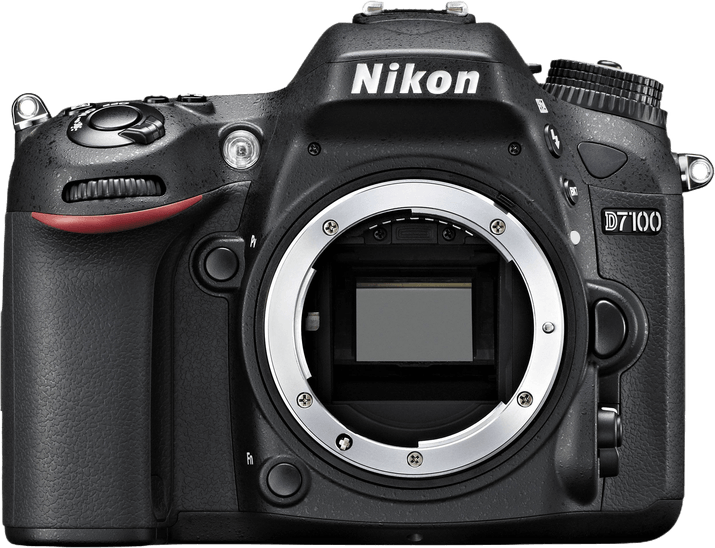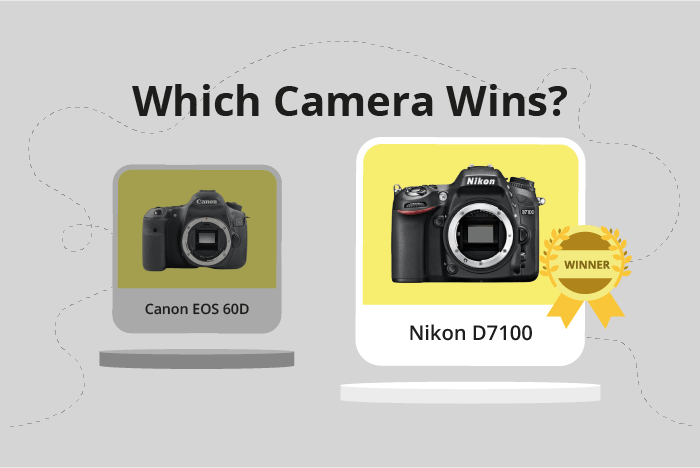Canon EOS 60D vs Nikon D7100 Comparison
Canon EOS 60D

Nikon D7100

The Nikon D7100 emerges as the winner with a score of 65/100, surpassing the Canon EOS 60D, which scored 47/100. Both cameras are DSLRs released in 2010 and 2013, respectively, with nearly identical launch prices of $1199 and $1200. They share similar dimensions and weight, with the Nikon D7100 measuring 136 x 107 x 76mm and weighing 765g, while the Canon EOS 60D measures 145 x 106 x 79mm and weighs 755g.
The Nikon D7100’s higher score reflects its superior performance and features compared to the Canon EOS 60D. However, the Canon EOS 60D does have some advantages, such as being slightly lighter and having a marginally larger body for improved ergonomics.
Considering the specifications and performance of both cameras, the Nikon D7100 stands out as the better choice due to its higher score, while the Canon EOS 60D may appeal to those who prioritize a lighter weight and larger grip.
Canon EOS 60D vs Nikon D7100 Overview and Optics
The Nikon D7100 outperforms the Canon EOS 60D in optics, with a score of 67/100 compared to the latter’s 43/100. Both cameras share several specifications, such as the CMOS sensor type, APS-C sensor size, and the absence of image stabilisation. However, the Nikon D7100 excels in certain aspects, which contribute to its higher score.
The D7100 boasts a higher megapixel count of 24.1, compared to the 60D’s 18 megapixels, allowing for more detailed and sharper images. Additionally, the D7100’s shooting speed of 6 frames per second (fps) surpasses the 60D’s 5.3 fps, enabling faster image capture for action shots or events. The D7100 also benefits from a more advanced processor, the Expeed 3, which contributes to better image quality and faster processing times than the 60D’s Digic 4 processor. Furthermore, the D7100’s sensor has a higher DXOMARK score of 83, compared to the 60D’s score of 66, signifying better overall sensor performance in terms of dynamic range, color depth, and low light capabilities.
Despite these advantages, the Canon EOS 60D offers a unique benefit with its Canon EF-S lens mount, which provides compatibility with a wide range of Canon lenses. This can be particularly advantageous for photographers who already own Canon lenses or prefer their selection.
Taking these factors into account, the Nikon D7100 emerges as the superior camera in terms of optics, with better specifications and performance. However, the Canon EOS 60D may still appeal to those who prioritize lens compatibility and are committed to the Canon ecosystem.
Canon EOS 60D vs Nikon D7100 Video Performance
The Nikon D7100 outperforms the Canon EOS 60D in video capabilities, with a video score of 57 to the Canon’s 43. Both cameras share some common video specifications, such as Full HD resolution, maximum video dimensions of 1920 x 1080, and a maximum video frame rate of 30fps. However, the Nikon D7100 has some advantages over the Canon EOS 60D that contribute to its higher score.
The most notable advantage of the Nikon D7100 is its built-in time-lapse functionality. This feature allows users to create stunning time-lapse videos without the need for additional equipment or software. The Canon EOS 60D, on the other hand, lacks this built-in function, which may be a drawback for some users.
While the Canon EOS 60D does not surpass the Nikon D7100 in video capabilities, it still offers Full HD resolution and a maximum video frame rate of 30fps. These features make the Canon EOS 60D suitable for users who require high-quality video recording, but may not need the added bonus of time-lapse functionality.
The Nikon D7100 is a clear winner when it comes to video capabilities, thanks to its higher video score and built-in time-lapse functionality. However, the Canon EOS 60D remains a viable option for those seeking Full HD resolution and a 30fps frame rate. Ultimately, the choice between these two cameras will depend on individual preferences and the specific video requirements of the user.
Canon EOS 60D vs Nikon D7100 Features and Benefits
The Nikon D7100 emerges as the winner in this comparison with a feature score of 59/100, slightly ahead of the Canon EOS 60D’s score of 57/100. Both cameras share some common specifications. They have similar screen sizes, with the 60D’s screen measuring 3 inches and the D7100’s at 3.2 inches. Neither camera has a touchscreen, GPS, or Bluetooth capabilities.
The Nikon D7100 outperforms the Canon EOS 60D in several aspects. Its screen resolution is higher at 1,228,800 dots, compared to the 60D’s 1,040,000 dots. This results in a sharper and clearer display for the user. Additionally, the D7100 has built-in WIFI, allowing for easier transfer of images and remote control of the camera through a smartphone or tablet.
On the other hand, the Canon EOS 60D has its own advantages. The most notable difference is its flip screen, which provides greater flexibility in composing shots from various angles. This feature can be especially useful for capturing images in challenging positions or for shooting video. The Nikon D7100 lacks this feature.
In conclusion, both cameras have their strengths and weaknesses. The Nikon D7100 offers a higher screen resolution and WIFI capabilities, making it the better choice for those who prioritize image clarity and connectivity. However, the Canon EOS 60D’s flip screen can be a deciding factor for photographers who require more versatility in composing their shots. Ultimately, the choice between these two cameras will depend on the specific needs and preferences of the user.
Canon EOS 60D vs Nikon D7100 Storage and Battery
The Nikon D7100 outperforms the Canon EOS 60D in storage and battery with a score of 76/100, compared to the Canon’s 45/100. Both cameras accept SD, SDHC, and SDXC memory cards and lack USB charging capabilities.
However, the Nikon D7100 holds an advantage with two memory card slots, allowing for greater storage capacity and flexibility. In contrast, the Canon EOS 60D has only one memory card slot. The Canon EOS 60D does have a slightly longer battery life of 1100 shots, compared to the Nikon D7100’s 950 shots. Despite this, the Nikon D7100’s battery type, EN-EL15, is generally more efficient and reliable than the Canon EOS 60D’s LP-E6 battery.
Considering these factors, the Nikon D7100 is the superior choice for storage and battery, with its dual memory card slots and efficient battery type. The Canon EOS 60D does offer a longer battery life, but it falls short in other aspects of storage and battery performance.
Canon EOS 60D vs Nikon D7100 – Our Verdict
Are you still undecided about which camera is right for you? Have a look at these popular comparisons that feature the Canon EOS 60D or the Nikon D7100:

